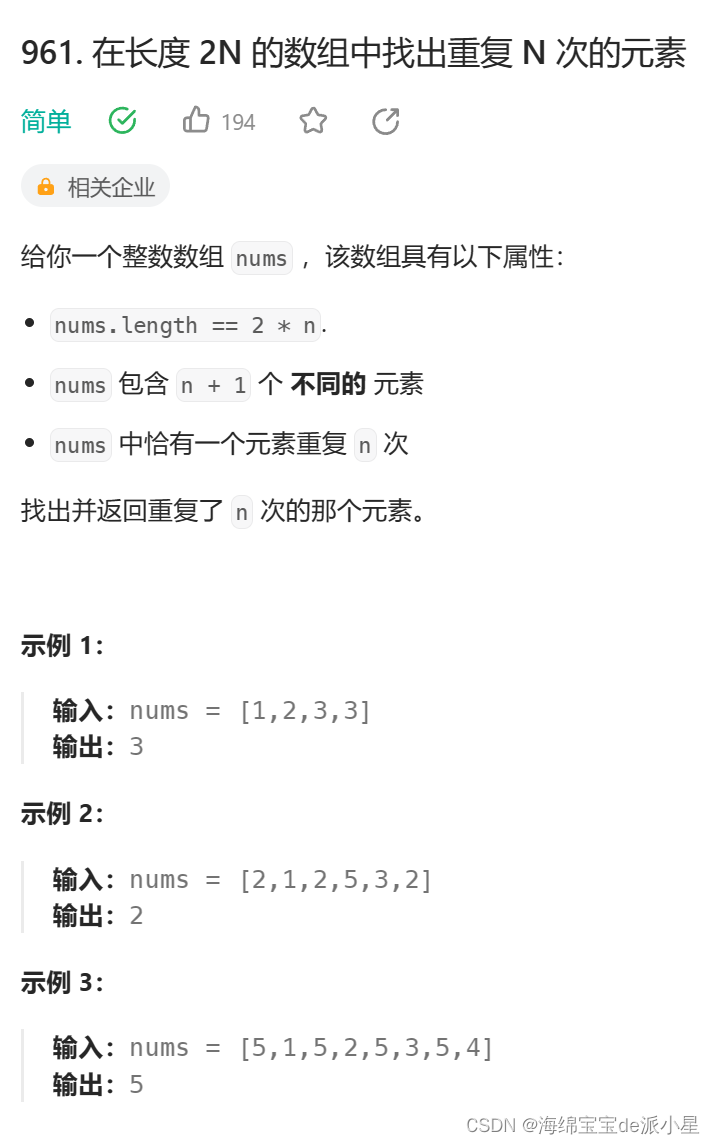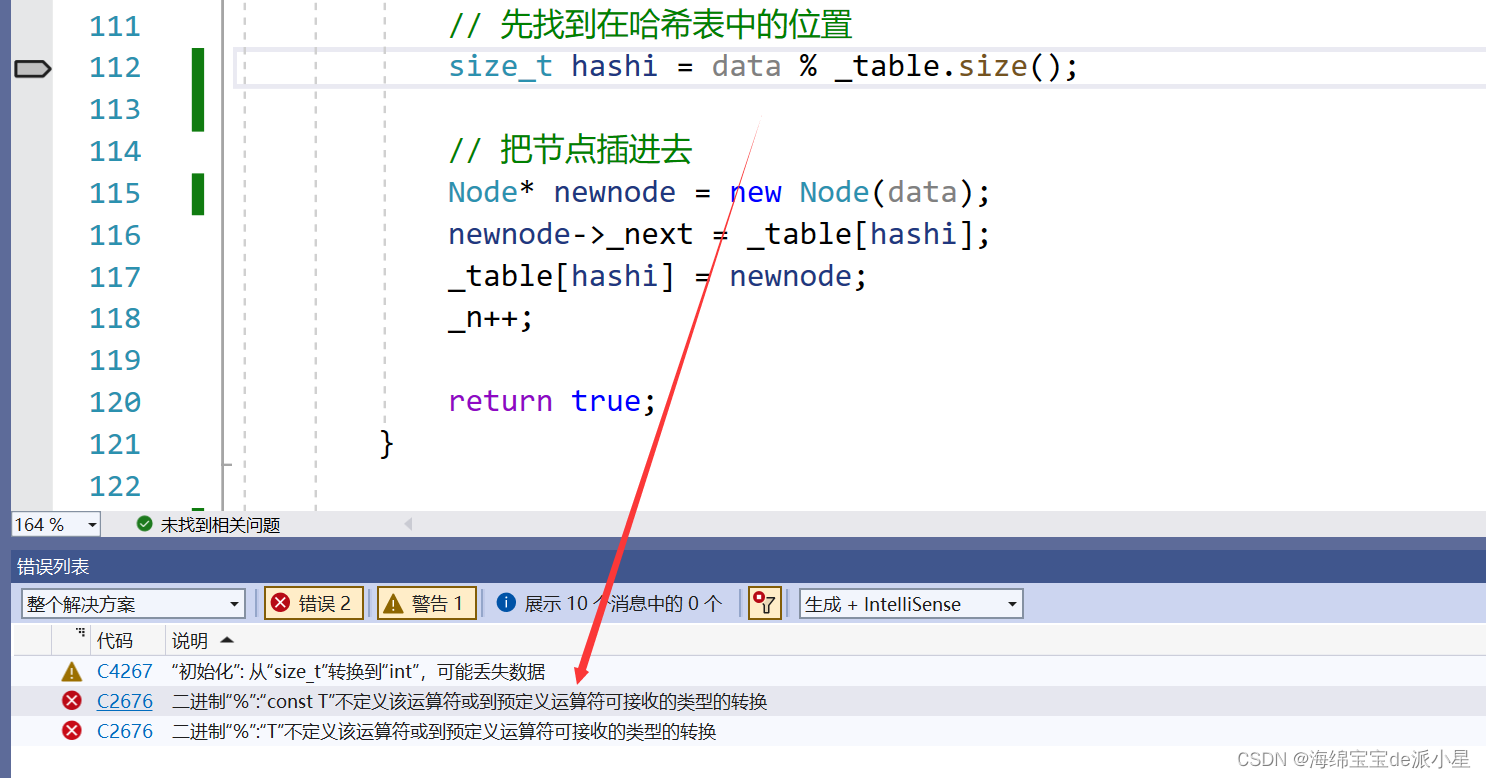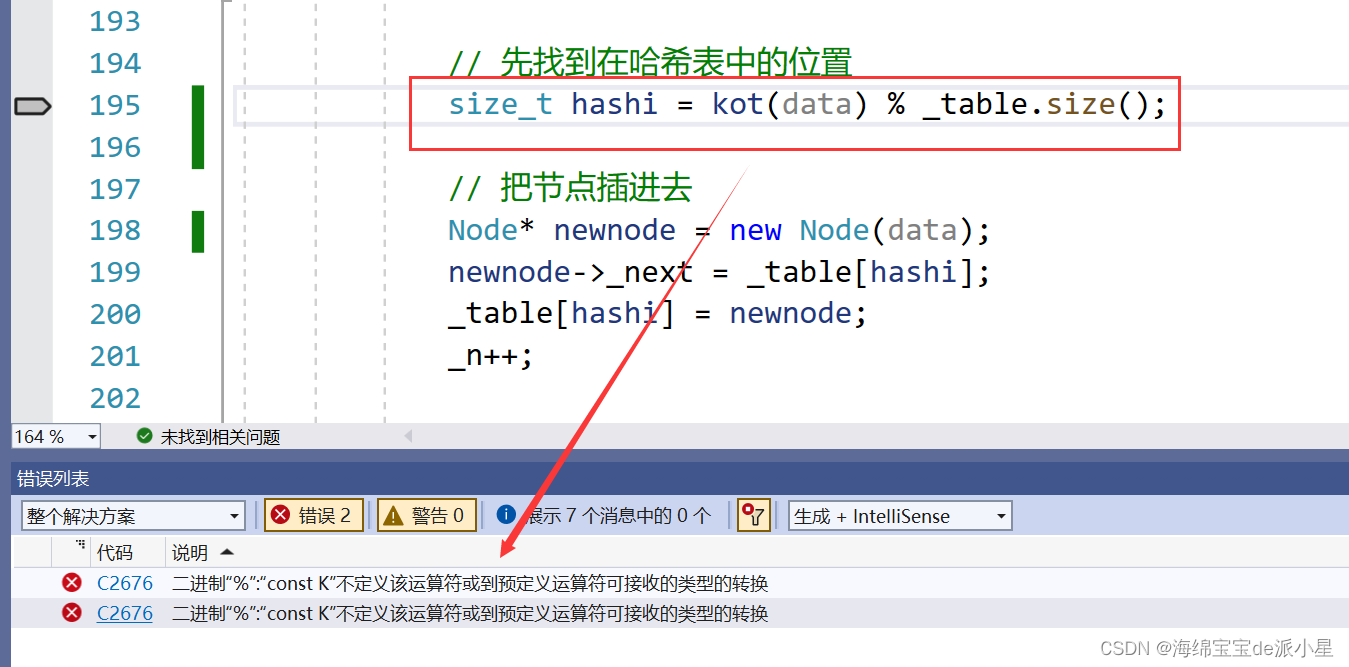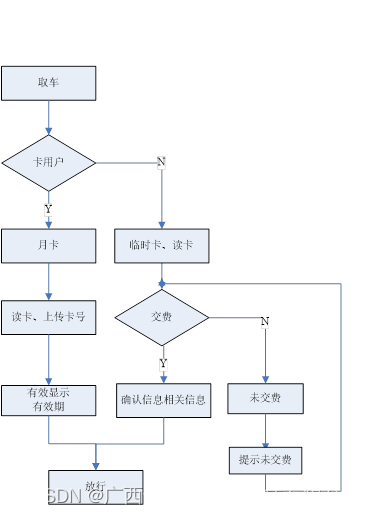文章目录
- unordered容器使用
- [在长度 2N 的数组中找出重复 N 次的元素](https://leetcode.cn/problems/n-repeated-element-in-size-2n-array/description/)
- 底层结构
- 初步改造哈希表
- 基本逻辑的实现
- 最终实现
本篇主要总结unordered系列容器和其底层结构
unordered容器使用
从使用的角度来讲,不管是unordered_map还是unordered_set,本质上就是把内容不再有序,而是采用无序的方式进行存储,对于其实现细节在后续会进行封装
在长度 2N 的数组中找出重复 N 次的元素

对于之前的方法,大多使用一种类似于计数排序的方法来解决问题
class Solution
{
public:
int repeatedNTimes(vector<int>& nums)
{
int hash[10001] = {0};
for(auto e : nums)
{
hash[e]++;
}
for(auto e : nums)
{
if(hash[e] != 1)
return e;
}
return -1;
}
};
而利用unordered_set,可以更方便的解决问题
class Solution {
public:
int repeatedNTimes(vector<int>& nums) {
unordered_set<int> found;
for (int num: nums) {
if (found.count(num)) {
return num;
}
found.insert(num);
}
// 不可能的情况
return -1;
}
};
底层结构
unordered系列的关联式容器,在进行查找等的效率比较高,究其原因是因为使用了哈希的结构,那么下面就利用哈希表,来对这两个容器进行封装
首先搭建出主体框架
// set
#pragma once
#include "HashTable.h"
namespace myset
{
template<class K>
class unordered_set
{
struct SetKeyOfT
{
K& operator()(K& key)
{
return key;
}
};
public:
bool insert(const K& key)
{
return _table.insert(key);
}
void print()
{
_table.print();
}
private:
opened_hashing::HashTable<K, K, SetKeyOfT> _table;
};
}
// map
#pragma once
#include "HashTable.h"
namespace mymap
{
template<class K, class V>
class unordered_map
{
struct MapKeyOfT
{
const K& operator()(const pair<K, V>& key)
{
return key.first;
}
};
public:
bool insert(const pair<K, V>& key)
{
return _table.insert(key);
}
void print()
{
_table.print();
}
private:
opened_hashing::HashTable<K, pair<K, V>, MapKeyOfT> _table;
};
}
// 测试函数
// 最基础的测试
void test_set1()
{
myset::unordered_set<int> st;
st.insert(1);
st.insert(2);
st.insert(60);
st.insert(50);
st.print();
}
void test_map1()
{
mymap::unordered_map<int, int> dict;
dict.insert(make_pair(1, 1));
dict.insert(make_pair(2, 2));
dict.insert(make_pair(3, 3));
dict.insert(make_pair(4, 4));
}
此时运行会报错

报错的原因是因为,对于map来说Value传递的是键值对,键值对不可以直接进行运算,因此要引入KeyOfT的概念,这里借助这个仿函数找到Key值

下面实现迭代器的内容:
对于哈希表来说,迭代器内部包含的就是一个一个节点的地址:
实现++
对于哈希表来说,实现++的逻辑可以看成,看当前节点的下一个还有没有值,如果没有就说明走到最后了,要找下一个哈希桶里面的内容,如果后面还有值,那就是下一个内容
那么如何记录所在的桶,可以通过对哈希表的位置进行定位来获取现在属于哪一桶,进而去寻找下一个桶
初步改造哈希表
#pragma once
#include <iostream>
#include <vector>
using namespace std;
namespace opened_hashing
{
template<class T>
struct _Convert
{
T& operator()(T& key)
{
return key;
}
};
template<>
struct _Convert<string>
{
size_t& operator()(const string& key)
{
size_t sum = 0;
for (auto e : key)
{
sum += e * 31;
}
return sum;
}
};
// 定义节点信息
template<class T>
struct Node
{
Node(const T& data)
:_next(nullptr)
, _data(data)
{}
Node* _next;
T _data;
};
template<class K, class T, class KeyOfT>
class HashTable;
template<class K, class T, class Ref, class Ptr, class KeyOfT>
struct _iterator
{
typedef _iterator<K, T, T&, T*, KeyOfT> Self;
typedef Node<T> Node;
_iterator(Node* node, HashTable<K, T, KeyOfT>* pht, int hashi)
:_node(node)
, _pht(pht)
, _hashi(hashi)
{}
Self operator++()
{
// 如果后面还有值,++就是到这个桶的下一个元素
if (_node->_next)
{
_node = _node->_next;
}
else
{
++_hashi;
while (_hashi < _pht->_table.size())
{
if (_pht->_table[_hashi])
{
_node = _pht->_table[_hashi];
break;
}
++_hashi;
}
if (_hashi == _pht->_table.size())
{
_node = nullptr;
}
}
return *this;
}
Ref operator*()
{
return _node->_data;
}
Ptr operator->()
{
return &_node->_data;
}
bool operator!=(const Self& s)
{
return _node != s._node;
}
Node* _node;
int _hashi; // 现在位于哪个桶
HashTable<K, T, KeyOfT>* _pht; // 迭代器所在的哈希表
};
template<class K, class T, class KeyOfT>
class HashTable
{
template<class K, class T, class Ref, class Ptr, class KeyOfT>
friend struct _iterator;
typedef Node<T> Node;
public:
typedef _iterator<K, T, T&, T*, KeyOfT> iterator;
// 构造函数
HashTable()
:_n(0)
{
_table.resize(10);
}
// 析构函数
~HashTable()
{
//cout << endl << "*******************" << endl;
//cout << "destructor" << endl;
for (int i = 0; i < _table.size(); i++)
{
//cout << "[" << i << "]->";
Node* cur = _table[i];
while (cur)
{
Node* next = cur->_next;
//cout << cur->_kv.first << " ";
delete cur;
cur = next;
}
//cout << endl;
_table[i] = nullptr;
}
}
// 迭代器
iterator begin()
{
for (int i = 0; i < _table.size(); i++)
{
if (_table[i])
{
return iterator(_table[i], this, i);
}
}
return end();
}
iterator end()
{
return iterator(nullptr, this, -1);
}
// 插入元素
bool insert(const T& data)
{
KeyOfT kot;
// 如果哈希表中有这个元素,就不插入了
if (find(data))
{
return false;
}
// 扩容问题
if (_n == _table.size())
{
HashTable newtable;
int newsize = (int)_table.size() * 2;
newtable._table.resize(newsize, nullptr);
for (int i = 0; i < _table.size(); i++)
{
Node* cur = _table[i];
while (cur)
{
Node* next = cur->_next;
// 把哈希桶中的元素插入到新表中
int newhashi = kot(cur->_data) % newsize;
// 头插
cur->_next = newtable._table[newhashi];
newtable._table[newhashi] = cur;
cur = next;
}
_table[i] = nullptr;
}
_table.swap(newtable._table);
}
// 先找到在哈希表中的位置
size_t hashi = kot(data) % _table.size();
// 把节点插进去
Node* newnode = new Node(data);
newnode->_next = _table[hashi];
_table[hashi] = newnode;
_n++;
return true;
}
Node* find(const T& Key)
{
KeyOfT kot;
// 先找到它所在的桶
int hashi = kot(Key) % _table.size();
// 在它所在桶里面找数据
Node* cur = _table[hashi];
while (cur)
{
if (cur->_data == Key)
{
return cur;
}
cur = cur->_next;
}
return nullptr;
}
private:
vector<Node*> _table;
size_t _n;
};
}
基本逻辑的实现
// set
#pragma once
#include "HashTable.h"
namespace myset
{
template<class K>
class unordered_set
{
struct SetKeyOfT
{
const K& operator()(const K& key)
{
return key;
}
};
typedef typename opened_hashing::HashTable<K, K, SetKeyOfT>::iterator iterator;
public:
iterator begin()
{
return _table.begin();
}
iterator end()
{
return _table.end();
}
bool insert(const K& key)
{
return _table.insert(key);
}
private:
opened_hashing::HashTable<K, K, SetKeyOfT> _table;
};
}
// map
#pragma once
#include "HashTable.h"
namespace mymap
{
template<class K, class V>
class unordered_map
{
struct MapKeyOfT
{
const K& operator()(const pair<K, V>& key)
{
return key.first;
}
};
typedef typename opened_hashing::HashTable<K, pair<K, V>, MapKeyOfT>::iterator iterator;
public:
iterator begin()
{
return _table.begin();
}
iterator end()
{
return _table.end();
}
bool insert(const pair<K, V>& key)
{
return _table.insert(key);
}
private:
opened_hashing::HashTable<K, pair<K, V>, MapKeyOfT> _table;
};
}
现在的主体框架已经搭建出来了,用下面的测试用例已经可以实现迭代器遍历了,证明我们的基本框架逻辑已经完成了
// 最基础的测试
void test_set1()
{
myset::unordered_set<int> st;
st.insert(1);
st.insert(2);
st.insert(60);
st.insert(50);
auto it = st.begin();
while (it != st.end())
{
cout << *it << " ";
++it;
}
cout << endl;
cout << endl;
cout << endl;
}
void test_map1()
{
mymap::unordered_map<int, int> dict;
dict.insert(make_pair(1, 1));
dict.insert(make_pair(10, 1));
dict.insert(make_pair(220, 1));
auto it = dict.begin();
while (it != dict.end())
{
cout << (*it).first << ":" << (*it).second << endl;
++it;
}
cout << endl;
}
但当遇到string类的内容就不可以继续进行了
// 带有string类的内容
void test_set2()
{
myset::unordered_set<string> st;
st.insert("apple");
st.insert("banana");
st.insert("pear");
st.insert("cake");
auto it = st.begin();
while (it != st.end())
{
cout << *it << " ";
++it;
}
cout << endl;
cout << endl;
cout << endl;
}
void test_map2()
{
mymap::unordered_map<string, string> dict;
dict.insert(make_pair("排序", "sort"));
dict.insert(make_pair("苹果", "apple"));
dict.insert(make_pair("香蕉", "banana"));
auto it = dict.begin();
while (it != dict.end())
{
cout << (*it).first << ":" << (*it).second << endl;
++it;
}
cout << endl;
}

还是前面出现过的原因,因为这里的kot取出来的是第一个元素,但是第一个元素是string,string是不能参与运算的,因此这里要再套一层仿函数来解决string类的问题
最终实现
改造后的哈希表
#pragma once
#include <iostream>
#include <vector>
using namespace std;
template <class T>
struct _HashT
{
const T& operator()(const T& Key)
{
return Key;
}
};
template<>
struct _HashT<string>
{
size_t operator()(const string& Key)
{
size_t sum = 0;
for (auto e : Key)
{
sum += e * 31;
}
return sum;
}
};
namespace opened_hashing
{
// 定义节点信息
template<class T>
struct Node
{
Node(const T& data)
:_next(nullptr)
, _data(data)
{}
Node* _next;
T _data;
};
template<class K, class T, class KeyOfT, class Hash>
class HashTable;
template<class K, class T, class Ref, class Ptr, class KeyOfT, class Hash>
struct _iterator
{
typedef _iterator<K, T, Ref, Ptr, KeyOfT, Hash> Self;
typedef Node<T> Node;
_iterator(Node* node, HashTable<K, T, KeyOfT, Hash>* pht, int hashi)
:_node(node)
, _pht(pht)
, _hashi(hashi)
{}
_iterator(Node* node, const HashTable<K, T, KeyOfT, Hash>* pht, int hashi)
:_node(node)
, _pht(pht)
, _hashi(hashi)
{}
Self operator++()
{
// 如果后面还有值,++就是到这个桶的下一个元素
if (_node->_next)
{
_node = _node->_next;
}
else
{
++_hashi;
while (_hashi < _pht->_table.size())
{
if (_pht->_table[_hashi])
{
_node = _pht->_table[_hashi];
break;
}
++_hashi;
}
if (_hashi == _pht->_table.size())
{
_node = nullptr;
}
}
return *this;
}
Ref operator*()
{
return _node->_data;
}
Ptr operator->()
{
return &_node->_data;
}
bool operator!=(const Self& s) const
{
return _node != s._node;
}
Node* _node;
int _hashi; // 现在位于哪个桶
const HashTable<K, T, KeyOfT, Hash>* _pht; // 迭代器所在的哈希表
};
template<class K, class T, class KeyOfT, class Hash>
class HashTable
{
template<class K, class T, class Ref, class Ptr, class KeyOfT, class Hash>
friend struct _iterator;
typedef Node<T> Node;
public:
typedef _iterator<K, T, T&, T*, KeyOfT, Hash> iterator;
typedef _iterator<K, T, const T&, const T*, KeyOfT, Hash> const_iterator;
// 构造函数
HashTable()
:_n(0)
{
_table.resize(10);
}
// 析构函数
~HashTable()
{
//cout << endl << "*******************" << endl;
//cout << "destructor" << endl;
for (int i = 0; i < _table.size(); i++)
{
//cout << "[" << i << "]->";
Node* cur = _table[i];
while (cur)
{
Node* next = cur->_next;
//cout << cur->_kv.first << " ";
delete cur;
cur = next;
}
//cout << endl;
_table[i] = nullptr;
}
}
// 迭代器
iterator begin()
{
for (int i = 0; i < _table.size(); i++)
{
if (_table[i])
{
return iterator(_table[i], this, i);
}
}
return end();
}
iterator end()
{
return iterator(nullptr, this, -1);
}
const_iterator begin() const
{
for (int i = 0; i < _table.size(); i++)
{
if (_table[i])
{
return const_iterator(_table[i], this, i);
}
}
return end();
}
const_iterator end() const
{
return const_iterator(nullptr, this, -1);
}
// 插入元素
bool insert(const T& data)
{
KeyOfT kot;
Hash ht;
// 如果哈希表中有这个元素,就不插入了
if (find(data))
{
return false;
}
// 扩容问题
if (_n == _table.size())
{
HashTable newtable;
int newsize = (int)_table.size() * 2;
newtable._table.resize(newsize, nullptr);
for (int i = 0; i < _table.size(); i++)
{
Node* cur = _table[i];
while (cur)
{
Node* next = cur->_next;
// 把哈希桶中的元素插入到新表中
int newhashi = ht(kot(cur->_data)) % newsize;
// 头插
cur->_next = newtable._table[newhashi];
newtable._table[newhashi] = cur;
cur = next;
}
_table[i] = nullptr;
}
_table.swap(newtable._table);
}
// 先找到在哈希表中的位置
size_t hashi = ht(kot(data)) % _table.size();
// 把节点插进去
Node* newnode = new Node(data);
newnode->_next = _table[hashi];
_table[hashi] = newnode;
_n++;
return true;
}
Node* find(const T& Key)
{
KeyOfT kot;
Hash ht;
// 先找到它所在的桶
int hashi = ht(kot(Key)) % _table.size();
// 在它所在桶里面找数据
Node* cur = _table[hashi];
while (cur)
{
if (cur->_data == Key)
{
return cur;
}
cur = cur->_next;
}
return nullptr;
}
private:
vector<Node*> _table;
size_t _n;
};
}
封装后的哈希结构
// set
#pragma once
#include "HashTable.h"
namespace myset
{
template<class K, class Hash = _HashT<K>>
class unordered_set
{
struct SetKeyOfT
{
const K& operator()(const K& key)
{
return key;
}
};
typedef typename opened_hashing::HashTable<K, K, SetKeyOfT, Hash>::const_iterator iterator;
typedef typename opened_hashing::HashTable<K, K, SetKeyOfT, Hash>::const_iterator const_iterator;
public:
const_iterator begin() const
{
return _table.begin();
}
const_iterator end() const
{
return _table.end();
}
bool insert(const K& key)
{
return _table.insert(key);
}
private:
opened_hashing::HashTable<K, K, SetKeyOfT, Hash> _table;
};
}
// map
#pragma once
#include "HashTable.h"
namespace mymap
{
template<class K, class V, class Hash = _HashT<K>>
class unordered_map
{
struct MapKeyOfT
{
const K& operator()(const pair<const K, V>& key)
{
return key.first;
}
};
typedef typename opened_hashing::HashTable<K, pair<const K, V>, MapKeyOfT, Hash >::iterator iterator;
typedef typename opened_hashing::HashTable<K, pair<const K, V>, MapKeyOfT, Hash >::const_iterator const_iterator;
public:
iterator begin()
{
return _table.begin();
}
iterator end()
{
return _table.end();
}
bool insert(const pair<const K, V>& key)
{
return _table.insert(key);
}
private:
opened_hashing::HashTable<K, pair<const K, V>, MapKeyOfT, Hash> _table;
};
}








![[java进阶]——泛型类、泛型方法、泛型接口、泛型的通配符](https://img-blog.csdnimg.cn/ea30a93024f64550803e8f4a42cff403.png)
![2023年中国绕包线行业产量及发展前景分析:市场规模将持续上升[图]](https://img-blog.csdnimg.cn/img_convert/a451a224e579307528c5f9d84d0cf620.png)







![2023年中国聚氨酯树脂涂料需求量、市场规模及行业趋势分析[图]](https://img-blog.csdnimg.cn/img_convert/23b79af19c919003a219a25dd00619c9.png)

